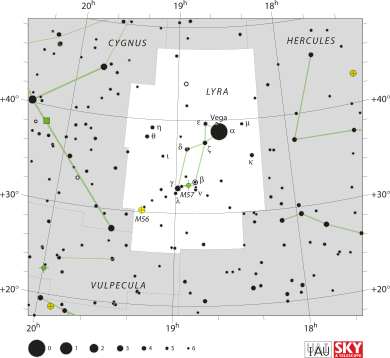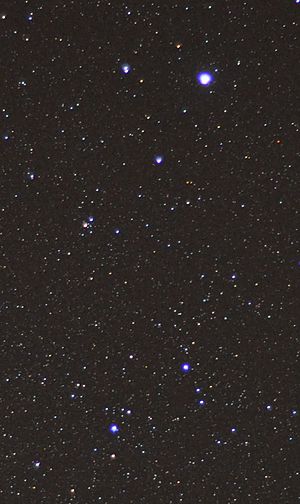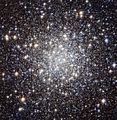Lyra facts for kids
| Constellation | |

List of stars in Lyra
|
|
| Abbreviation | Lyr |
|---|---|
| Genitive | Lyrae |
| Pronunciation | genitive |
| Symbolism | Lyre, harp |
| Right ascension | 19 |
| Declination | +40 |
| Quadrant | NQ4 |
| Area | 286 sq. deg. (52nd) |
| Main stars | 5 |
| Bayer/Flamsteed stars |
25 |
| Stars with planets | 62 |
| Stars brighter than 3.00m | 1 |
| Stars within 10.00 pc (32.62 ly) | 3 |
| Brightest star | Vega (α Lyr) (0.03m) |
| Messier objects | 2 |
| Meteor showers | Lyrids June Lyrids Alpha Lyrids |
| Bordering constellations |
Draco Hercules Vulpecula Cygnus |
| Visible at latitudes between +90° and −40°. Best visible at 21:00 (9 p.m.) during the month of August. |
|
Lyra is a small but bright constellation in the northern sky. It looks like a small harp or lyre. This constellation is easy to find because it contains Vega, one of the brightest stars we can see from Earth.
Lyra is part of the Hercules family of constellations. It is best seen in the Northern Hemisphere during summer evenings.
Contents
What is the Lyra Constellation?
Lyra is a small constellation, but it's very famous. It is shaped like a small musical instrument called a lyre or harp. In ancient times, people used lyres to play music.
Finding Lyra in the Sky
You can spot Lyra high in the sky during summer nights in the Northern Hemisphere. It's usually visible from April to November. The best time to see it is in August.
How Big is Lyra?
Lyra covers an area of 286 square degrees in the sky. This makes it the 52nd largest constellation out of 88.
Vega: The Brightest Star in Lyra
The brightest star in Lyra is called Vega. It is also known as Alpha Lyrae. Vega is one of the brightest stars in the entire night sky.
Why is Vega So Bright?
Vega shines with a magnitude of 0.03, which is very bright. It is about 25 light-years away from Earth. This star is a very important one for astronomers.
Vega's Importance
Vega was once the North Star thousands of years ago. This means it was the star closest to the North Pole. It will be the North Star again in about 12,000 years!
Cool Objects in Lyra
Lyra is home to some amazing objects that you can see with a telescope. These include star clusters and nebulae.
Messier 56: A Globular Cluster
Messier 56 (or M56) is a globular cluster in Lyra. A globular cluster is a huge ball of thousands of stars, all held tightly together by gravity.
M56's Distance and Size
M56 is about 32,900 light-years away from us. It is also quite large, stretching about 85 light-years across.
Messier 57: The Ring Nebula
Messier 57 (or M57) is one of the most famous objects in Lyra. It is known as the Ring Nebula.
What is the Ring Nebula?
The Ring Nebula is a type of planetary nebula. This is what's left after a star like our Sun runs out of fuel and sheds its outer layers. It looks like a colorful ring or smoke puff in space.
Meteor Showers from Lyra
Lyra is also known for a meteor shower called the Lyrids. Meteor showers happen when Earth passes through a trail of dust left by a comet.
When to See the Lyrids
The Lyrids meteor shower happens every year in April. You can see bright streaks of light, called meteors, appearing to come from the direction of Lyra.
Images for kids
-
Messier 56 is composed of a large number of stars, tightly bound to each other by gravity. In Lyra are the objects M56, M57, and Kuiper 90. M56 is a rather loose globular cluster at a distance of approximately 32,900 light-years, with a diameter of about 85 light-years. Its apparent brightness is 8.3m.
See also
 In Spanish: Lyra para niños
In Spanish: Lyra para niños




